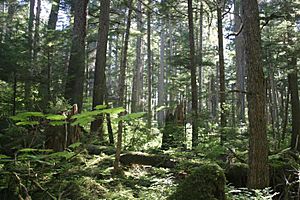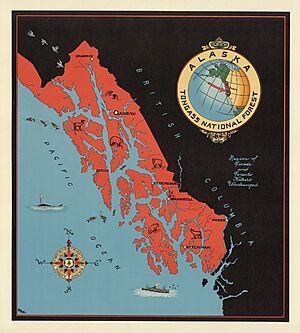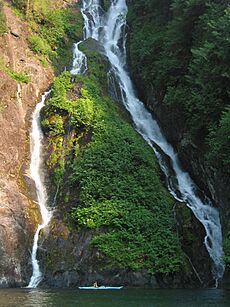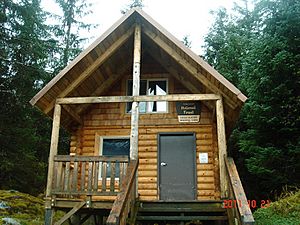Tongass National Forest facts for kids
Quick facts for kids Tongass National Forest |
|
|---|---|
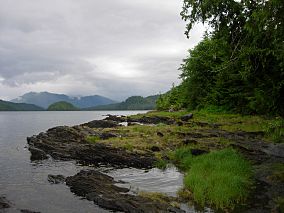
The Tongass National Forest near Ketchikan, Alaska
|
|
| Location | Alaska Panhandle, Alaska, U.S. |
| Area | 16.7 million acres (26,100 sq mi; 68,000 km2) |
| Established | 10 September 1907 |
| Visitors | 1,881,000 (in 2006–2007) |
| Governing body | United States Forest Service |
| Website | Tongass National Forest |
The Tongass National Forest is a huge forest in Southeast Alaska. It is the largest U.S. National Forest, covering about 16.7 million acres. That's a lot of land! Most of the Tongass is a temperate rain forest. It is so wild that many rare and endangered plants and animals live there.
The United States Forest Service manages the Tongass. It includes many islands, deep fjords, huge glaciers, and tall mountains. Part of the forest is right on the border with Canada. The main office for the forest is in Ketchikan. There are also smaller offices in towns like Juneau and Sitka.
Contents
History of the Tongass Forest
The Tongass National Forest was created a long time ago. President Theodore Roosevelt first set aside some of this land in 1902. Then, on September 10, 1907, he officially created the Tongass National Forest. A year later, in 1908, two forest areas were combined. This made the Tongass cover most of Southeast Alaska. Later, other presidents like Calvin Coolidge added even more land to the forest.
In 1971, a plane crash happened in the Tongass National Forest. Sadly, all 111 people on board Alaska Airlines Flight 1866 died.
Land Rights for Native People
After the Tongass National Forest was created, the Tlingit and Haida Native tribes of Alaska felt their land rights were not respected. In 1935, they formed a group to challenge the government. They argued that they had lived on and used this land for a very long time.
A court agreed with the Native tribes. It said that the creation of the Tongass National Forest took land from them. In 1968, the case was settled. The Native tribes received $7.5 million for the land. This amount was based on the land's value back in 1902.
Logging in the Forest
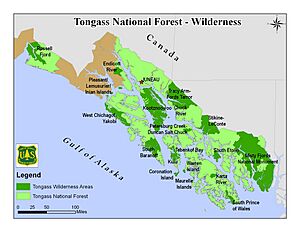
For many years, logging was a big part of the Tongass economy. In the 1950s, the Forest Service made long-term deals with two large companies. These deals allowed them to cut trees for 50 years. However, these companies sometimes caused problems. They tried to lower log prices and hurt smaller logging businesses. They also polluted local areas.
People began to fight against some of the logging practices. In the 1970s, a group challenged the cutting of old-growth forests. They wanted to protect areas, especially near salmon streams.
In 1990, a new law called the Tongass Timber Reform Act changed things. This law stopped a large government payment for timber cutting. It also created new protected areas where logging was not allowed. The law made sure that logging had to be reviewed to protect the environment. Because of these new rules, the two big logging companies closed their mills in the 1990s.
Today, the government tries to make sure that timber sales in the Tongass make money. However, the Forest Service still spends money on things like planning and managing these sales. This means the government does not always make a profit from logging.
Logging in the past often focused on the biggest and most valuable trees. This is called "high-grading." Many of these large, old trees have already been cut.
In 2021, the government decided to stop large-scale logging of old-growth trees in the Tongass. Now, the focus is on restoring the forest, recreation, and other uses. Smaller timber sales are still allowed for local communities.
About the Tongass
The U.S. Forest Service calls the Tongass the "crown jewel." It is Alaska's biggest National Forest. It is also one of the last large temperate rainforests left in the world. About 70,000 people live in this region.
For a long time, logging was the main business. But now, other things bring money to the area. These include tourism, fishing, and scientific research. Tourism alone supports over 10,000 jobs in the Tongass.
Three Alaska Native groups live in Southeast Alaska. They are the Tlingit, Haida, and Tsimshian. There are 31 communities inside the forest. The largest is Juneau, which is Alaska's capital city. The forest is named after the Tongass group of the Tlingit people. They lived in the southern part of Southeast Alaska.
Forest Ecology and Wildlife
The Tongass is part of a special rainforest zone. It has many western red cedar, sitka spruce, and western hemlock trees. It is the largest temperate rainforest on Earth. The ground under the forest is either karst (limestone rock with good drainage and caves) or granite (rock with poor drainage).
Many unique animals live in the Tongass. You might not find them anywhere else in North America. Five types of salmon live here. You can also find brown and black bears, and many bald eagles. Other animals include wolves, mountain goats, and sitka black-tailed deer. Many birds come here to nest in the summer.
In the waters offshore, you can see orca and humpback whales. There are also sea lions, seals, sea otters, and porpoises. The Tongass is also home to a very rare type of weasel called the Haida ermine. It is only found here and on the Haida Gwaii islands in Canada.
Even though the forest is huge, about 40% of it is wetlands, snow, ice, or rock. The rest is forest. About 5 million acres are "productive old-growth" forest. A large part of this old-growth forest is protected.
The forest can be affected by strong winds and landslides. Strong winter storms, called "Takus," can blow down trees.
Most of the remaining old-growth forest will never be cut. Plans are to stop cutting old-growth trees. Instead, the focus will be on managing and harvesting trees from younger, already-cut areas.
Wilderness Areas
The Tongass National Forest has 19 special wilderness areas. This is more than any other national forest. These areas cover over 5.75 million acres. They are protected so they can stay wild and untouched.
- Misty Fjords National Monument Wilderness
- Kootznoowoo Wilderness
- Tracy Arm-Fords Terror Wilderness
- Stikine-LeConte Wilderness
- Russell Fjord Wilderness
- South Baranof Wilderness
- West Chichagof-Yakobi Wilderness
- Endicott River Wilderness
- South Prince of Wales Wilderness
- South Etolin Wilderness
- Chuck River Wilderness
- Tebenkof Bay Wilderness
- Kuiu Wilderness
- Petersburg Creek-Duncan Salt Chuck Wilderness
- Karta River Wilderness
- Pleasant/Lemesurier/Inian Islands Wilderness
- Coronation Island Wilderness
- Warren Island Wilderness
- Maurille Islands Wilderness
There are also other wilderness areas in Southeast Alaska. Some are managed by the United States Fish and Wildlife Service. Others are part of national parks like Glacier Bay Wilderness.
Fun Things to Do
The Tongass National Forest offers many fun activities. Some of these can only be found in Alaska. Almost one million people visit the forest each year. Most visitors come on cruise ships through the Inside Passage.
The Forest Service has visitor centers to help people learn about the forest. The Mendenhall Glacier Visitor Center in Juneau was the first of its kind in the country. There is also the Southeast Alaska Discovery Center in Ketchikan.
Native Land Holdings
In 1971, a law called the Alaska Native Claims Settlement Act (ANCSA) was passed. This law gave about 44 million acres of federal land in Alaska to private Native corporations. About 632,000 acres of this land came from the Tongass National Forest. These lands are now owned by groups like Sealaska Corporation.
When public land becomes privately owned, it is no longer protected by federal laws. This means the owners can use the land as they wish. This has caused some disagreements. People worry about how private land use might affect the surrounding forest and its wildlife.
Sealaska, a Native corporation, has asked for more land. They were promised land that was not available before. Now, they are asking for new land that is valuable for both its economy and its environment. This request has caused a lot of discussion in Southeast Alaska. Some people are worried about how it might affect the forest and its animals.
Images for kids
See also
 In Spanish: Bosque nacional Tongass para niños
In Spanish: Bosque nacional Tongass para niños



